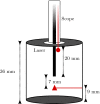A temperature model for laser lithotripsy
- PMID: 32710217
- PMCID: PMC8217062
- DOI: 10.1007/s00345-020-03357-y
A temperature model for laser lithotripsy
Abstract
Objective: To derive and validate a mathematical model to predict laser-induced temperature changes in a kidney during kidney stone treatment.
Methods: A simplified mathematical model to predict temperature change in the kidney for any given renal volume, irrigation flow rate, irrigation fluid temperature, and laser power was derived. We validated our model with matched in vitro experiments.
Results: Excellent agreement between the mathematical model predictions and laboratory data was obtained.
Conclusion: The model obviates the need for repeated experimental validation. The model predicts scenarios where risk of renal tissue damage is high. With real-time knowledge of flow rate, irrigating fluid temperature and laser usage, safety warning levels could be predicted. Meanwhile, clinicians should be aware of the potential risk from thermal injury and take measures to reduce the risk, such as using room temperature irrigation fluid and judicious laser use.
Keywords: In vitro experiments; Lithotripsy; Mathematical modelling; Thermal tissue damage.
Conflict of interest statement
Boston Scientific provided equipment for experiments and funding to support research time for J.G. Williams as part of a joint funding project with industry. B.W. Turney is a consultant for Boston Scientific.
Figures









References
-
- Kupeli Bora, Tunc Lutfi, Acar Cenk, Gurocak Serhat, Alkibay Turgut, Guneri Cagri, Bozkirli Ibrahim. The impact of pelvicaliceal anatomical variation between the stone-bearing and normal contralateral kidney on stone formation in adult patients with lower caliceal stones. Int Braz J Urol. 2006;32(3):287–292. doi: 10.1590/s1677-55382006000300005. - DOI - PubMed
MeSH terms
LinkOut - more resources
Full Text Sources
Other Literature Sources

